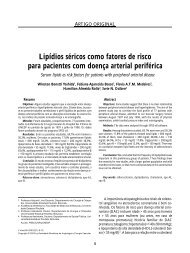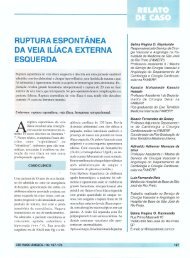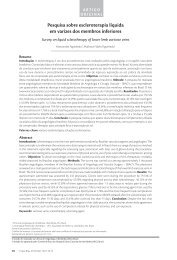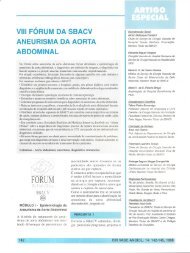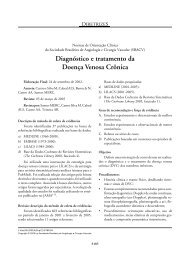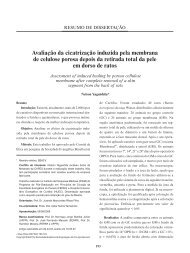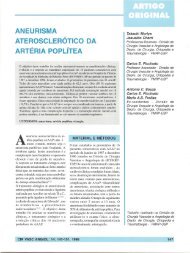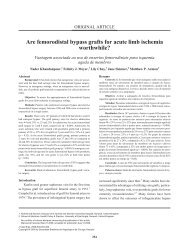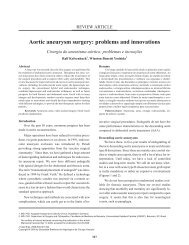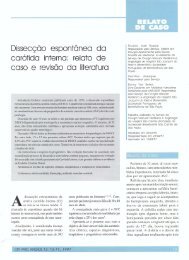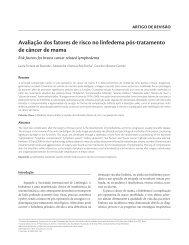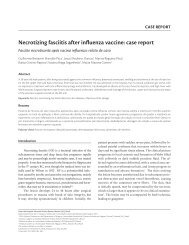258J Vasc Bras 2010, Vol. 9, Nº 4<strong>Atrial</strong> <strong>embolism</strong> after micr<strong>of</strong>oam ultrasound-guided sclero<strong>the</strong>rapy - Lopes RPF et al.normal sinus rhythm. At physical examination, a dilatedand pulsatile <strong>great</strong>er <strong>saphenous</strong> <strong>vein</strong> (GSV) at <strong>the</strong> saphen<strong>of</strong>emoraljunction (SFJ) on both lower limbs was observed(Figure 1). Preoperative duplex ultrasound showed <strong>the</strong>right saphen<strong>of</strong>emoral junction with 15 mm in diameter,dilatation and reflux in all <strong>the</strong> length <strong>of</strong> <strong>the</strong> GSV and invaricose tributary <strong>vein</strong>s, as well as a patent and competentdeep venous system.The procedure was performed in supine position anda tourniquet at <strong>the</strong> level <strong>of</strong> <strong>the</strong> patient’s knee. The <strong>great</strong>er<strong>saphenous</strong> <strong>vein</strong> was punctured with Jelco 18-gauge needleat <strong>the</strong> distal portion <strong>of</strong> <strong>the</strong> thigh using Doppler ultrasoundguidance. Micr<strong>of</strong>oam was prepared by mixing polidocanol3% and room air in a 1:4 proportion (Tessari method);afterwards, 8 mL <strong>of</strong> this solution was injected under realtimeultrasound guidance, while <strong>the</strong> limb was kept in a45-degree elevation and <strong>the</strong> saphen<strong>of</strong>emoral junction wasFigure 1 - Dilated, visible and pulsatile <strong>great</strong> <strong>saphenous</strong> <strong>vein</strong> at physicalexamination <strong>of</strong> <strong>the</strong> right thighcompressed by an ultrasound transducer. The right lowerlimb and <strong>the</strong> saphen<strong>of</strong>emoral junction were maintained in<strong>the</strong> same position for ten minutes and, <strong>the</strong>n, <strong>the</strong> whole limbwas wrapped with a compression inelastic bandage for 24hours. There were no intercurrences during <strong>the</strong> procedure,and elastic stockings (30-40 mmHg <strong>of</strong> pressure) were prescribedfor 30 days.The patient returned seven days after <strong>the</strong> procedurewith clear subjective clinical improvement. Follow-upDoppler ultrasound showed total occlusion <strong>of</strong> <strong>the</strong> <strong>great</strong>er<strong>saphenous</strong> <strong>vein</strong> in <strong>the</strong> two distal thirds <strong>of</strong> <strong>the</strong> thigh. Theproximal segment <strong>of</strong> <strong>the</strong> <strong>great</strong> <strong>saphenous</strong> <strong>vein</strong> was partiallyoccluded, and Doppler ultrasound also showed a <strong>floating</strong><strong>thrombus</strong> in <strong>the</strong> saphen<strong>of</strong>emoral junction, that fragmentedduring <strong>the</strong> ultrasound examination. There were no signs <strong>of</strong>deep venous thrombosis (DVT). The <strong>thrombus</strong> was immediatelyidentified ascending <strong>the</strong> inferior vena cava, and immediately<strong>the</strong>reafter, transthoracic echocardiogram showeda <strong>floating</strong> embolus in <strong>the</strong> right atrium (Figure 2). The patientwas placed in left lateral decubitus position and sentto <strong>the</strong> Intensive Care Unit. The absence <strong>of</strong> thrombi on <strong>the</strong>saphen<strong>of</strong>emoral junction allowed emergency ligation-division<strong>of</strong> <strong>the</strong> <strong>great</strong>er <strong>saphenous</strong> <strong>vein</strong>, under local anes<strong>the</strong>sia.Anticoagulation <strong>the</strong>rapy with unfractionated heparin wasinitiated. At repeat transthoracic echocardiogram two dayslater, <strong>the</strong> embolus was no longer seen. Arterial blood gaswas normal and helical CT scan showed no signs <strong>of</strong> pulmonary<strong>embolism</strong> (PE). The patient was found to be asymptomaticand was discharged after five days on warfarinfor outpatient follow-up and anticoagulation control. Noevidence <strong>of</strong> DVT or PE was detected six months after <strong>the</strong>procedure and <strong>the</strong> anticoagulation <strong>the</strong>rapy was terminated.Informed consent was obtained from <strong>the</strong> patient in order toreport this case.DiscussionFigure 2 - Trans-thoracic echocardiogram showing <strong>floating</strong> embolus in<strong>the</strong> right atriumMS is a promising <strong>the</strong>rapeutic procedure that has beenradically changing <strong>the</strong> management <strong>of</strong> varicose <strong>vein</strong>s 1,2 . Theadoption <strong>of</strong> fast micr<strong>of</strong>oam preparation systems and routineguidance by Doppler ultrasound have increased <strong>the</strong> interestin <strong>the</strong> method, which may be performed in outpatientclinics without anes<strong>the</strong>sia in one or more sessions, besidesresulting in a shorter recovering period in comparison toclassic surgery 1,3,4 . Virtually all kinds <strong>of</strong> varicose <strong>vein</strong>s canbe treated even when <strong>the</strong> conventional surgical treatmenthas limitations, includind instances in which conventionalsurgical treatment present limitations, such as patients <strong>of</strong>functional classifications CEAP C4, C5 and C6, recurrent
<strong>Atrial</strong> <strong>embolism</strong> after micr<strong>of</strong>oam ultrasound-guided sclero<strong>the</strong>rapy - Lopes RPF et al. J Vasc Bras 2010, Vol. 9, Nº 4 259varicose <strong>vein</strong>s and high surgical risk patients 3,4 . The number<strong>of</strong> publications on <strong>the</strong> method is increasing, but <strong>the</strong>re is stillno consensus regarding indications and contraindications,technical variations and <strong>the</strong> rate <strong>of</strong> complications 5,6 .The efficacy and safety <strong>of</strong> <strong>the</strong> method have been emphasizedby many studies 1,3,6 , but only a relatively smallnumber <strong>of</strong> complications, <strong>of</strong>ten not severe, has been published1,2,4 . However, <strong>the</strong> actual incidence <strong>of</strong> complicationsis unknown 2 , and potentially severe and lethal events havealready been described, including <strong>the</strong> rare and well-documentedcase <strong>of</strong> stroke in a patient with an 18-mm patentoval foramen and left shunt 7 , and a case <strong>of</strong> cardiorespiratoryarrest associated with polidocanol sclero<strong>the</strong>rapy forvenous malformation in a child with Klippel-Trenaunaysyndrome 8 .Extravasation <strong>of</strong> <strong>the</strong> sclerosing agent into <strong>the</strong> deep venoussystem through perforating <strong>vein</strong>s or at <strong>the</strong> saphen<strong>of</strong>emoraljunction during <strong>the</strong> procedure may be responsiblefor some <strong>of</strong> <strong>the</strong>se complications. Some ways <strong>of</strong> avoiding ithave been described, including digital compression or ultrasonographicmonitoring during sclerosing agent injection1,9,10 . A prospective, controlled and randomized trialsuggested that SFJ ligature under local anes<strong>the</strong>sia prior to<strong>the</strong> GSV sclero<strong>the</strong>rapy increases <strong>the</strong> procedure safety bylimiting <strong>the</strong> extravasation 11 . Recently, Bidwai et al. proposeda clipping ligature <strong>of</strong> <strong>the</strong> perforating <strong>vein</strong>s under local anes<strong>the</strong>siaafter locating <strong>the</strong>m by means <strong>of</strong> Doppler ultrasoundand SFJ monitoring by Fogarty balloon ca<strong>the</strong>ter 12 .Delayed major complications are rare and almost exclusivelypresent as venous thrombosis, which is <strong>of</strong>ten asymptomaticand diagnosed by Doppler ultrasound within 7 to14 days after <strong>the</strong> procedure 2,4 . DVT is commonly limited to<strong>the</strong> calf muscular <strong>vein</strong>s or tibial <strong>vein</strong>s. Femoral or poplitealDVT rarely occurs by direct extension <strong>of</strong> thrombosis from<strong>the</strong> saphen<strong>of</strong>emoral/saphenopopliteal junctions or perforating<strong>vein</strong>s 9,10 . A large prospective multicenter study <strong>of</strong> 12,173sclero<strong>the</strong>rapy sessions reported one single case <strong>of</strong> femoralDVT and no case <strong>of</strong> <strong>embolism</strong> 2 . Yamaki et al. reporteda DVT case with symptomatic PE after ligature <strong>of</strong> <strong>the</strong> <strong>great</strong><strong>saphenous</strong> <strong>vein</strong> associated with polidocanol sclero<strong>the</strong>rapy 13 .Compression <strong>of</strong> <strong>the</strong> limb after sclero<strong>the</strong>rapy reduces<strong>the</strong> pathological reflow and <strong>the</strong> diameter <strong>of</strong> <strong>the</strong> treated <strong>vein</strong>,besides reducing <strong>the</strong> DVT risk 3 . It should be performed immediatelyafter <strong>the</strong> <strong>the</strong>rapy session in all patients. However,<strong>the</strong>re are nei<strong>the</strong>r consensus about <strong>the</strong> ideal compressionmethod and duration nor studies that confirm its unquestionablerelevance as an adjuvant to sclero<strong>the</strong>rapy 3,5,6 . In ourcase, it is probable that <strong>the</strong> wide diameter <strong>of</strong> <strong>the</strong> saphen<strong>of</strong>emoraljunction, associated with <strong>the</strong> pulsatility resultingfrom CHF and <strong>the</strong> difficulty in maintaining compressionafter <strong>the</strong> procedure have contributed to non-obliteration <strong>of</strong><strong>the</strong> <strong>great</strong> <strong>saphenous</strong> <strong>vein</strong> and <strong>the</strong> local <strong>floating</strong> <strong>thrombus</strong>formation. Although <strong>the</strong>re are not studies that determine amaximal acceptable diameter <strong>of</strong> <strong>the</strong> saphen<strong>of</strong>emoral junctionfor use <strong>of</strong> this method, <strong>the</strong> present clinical observationmay limit its indication for patients with wide SFJ and reducepossible complications.ConclusionMS is a promising treatment for varicose <strong>vein</strong>s becauseit is a simple, easily reproducible, less invasive, cost-effectiveand safe method 11 . However, it can rarely result in severecomplications like those reported in this paper. Someprecautions such as <strong>the</strong> patient careful selection, choice<strong>of</strong> <strong>the</strong> sclerosing agent and <strong>of</strong> <strong>the</strong> puncture site, compressive<strong>the</strong>rapy and <strong>the</strong> experience <strong>of</strong> <strong>the</strong> physician with o<strong>the</strong>rmethods <strong>of</strong> sclero<strong>the</strong>rapy – as well as his ability to diagnoseand treat possible complications – may increase <strong>the</strong> efficacyand safety <strong>of</strong> this procedure 3 .References1. Redondo P, Cabrera J. Micr<strong>of</strong>oam sclero<strong>the</strong>rapy. Semin Cutan MedSurg. 2005;24:175-83.2. Guex JJ, Allaert FA, Gillet JL, Chleir F. Immediate and midtermcomplications <strong>of</strong> sclero<strong>the</strong>rapy: report <strong>of</strong> a prospective multicenterregistry <strong>of</strong> 12,173 sclero<strong>the</strong>rapy sessions. Dermatol Surg.2005;31:123-28.3. Zimmet SE. Sclero<strong>the</strong>rapy treatment <strong>of</strong> telangiectasias and varicose<strong>vein</strong>s. Tech Vasc Interv Radiol. 2003;6:116-20.4. Munavalli GS, Weiss RA. Complications <strong>of</strong> sclero<strong>the</strong>rapy. SeminCutan Med Surg. 2007;26:22-8.5. Breu FX, Guggenbichler S. European Consensus Meeting on FoamSclero<strong>the</strong>rapy, April, 4-6, 2003, Tegernsee, Germany. Dermatol Surg.2004;30:709-17.6. Rabe E, Pannier-Fischer F, Gerlach H, Breu FX, Guggenbichler S,Zabel M; German Society <strong>of</strong> Phlebology. Guidelines for sclero<strong>the</strong>rapy<strong>of</strong> varicose <strong>vein</strong>s (ICD 10: I83.0, I83.1, I83.2 and I83.9). DermatolSurg. 2004;30:687-93.7. Forlee MV, Grouden M, Moore DJ, Shanik G. Stroke after varicose<strong>vein</strong> foam injection sclero<strong>the</strong>rapy. J Vasc Surg. 2006;43:162-4.8. Marrocco-Trischitta MM, Guerrini P, Abeni D, Stillo F. Reversiblecardiac arrest after polidocanol sclero<strong>the</strong>rapy <strong>of</strong> peripheral venousmalformation. Deramtol Surg. 2002;28:153-5.9. Smith PC. Chronic venous disease treated by ultrasoundguided foam sclero<strong>the</strong>rapy. Eur J Vasc Endovasc Surg. 2006;32:577-83.10. O’Hare JL, Earnshaw JJ. The use <strong>of</strong> foam sclero<strong>the</strong>rapy for varicose <strong>vein</strong>s:a survey <strong>of</strong> <strong>the</strong> members <strong>of</strong> <strong>the</strong> Vascular Society <strong>of</strong> Great Britain andIreland. Eur J Vasc Endovasc Surg. 2007;34: 232-5.



